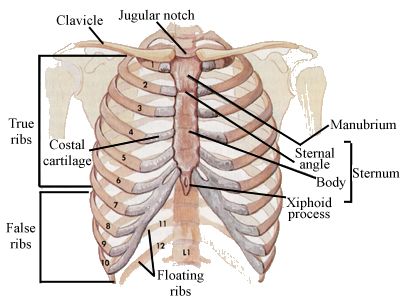rib-cage
A bony framework that protects the heart, lungs, and other underlying organs.
The rib-cage is made up of three types of bone – the sternum (breastbone),
12 pairs of ribs, and 12 thoracic vertebrae.
All of the ribs attach to the spinal column, but only the top seven pairs connect to the sternum.
These are called true ribs and are connected to the sternum by strips of cartilage known as costal cartilage.
The next three pairs of ribs are known as false ribs. Instead of attaching directly to they sternum,
they all attach to the lowest true rib.
The last two pairs of ribs are called floating ribs and attach only to the spine.
Upon inhalation, muscles between the ribs, called intercostal muscles,
lift the ribcage helping the lungs to expand. Upon exhalation,
the rib-cage moves down, squeezing air out of the lungs.
Symptoms
The symptoms of rib injuries depend on the type and severity of the injury, but can include:
- Pain at the injury site
- Pain when the ribcage flexes – for example when you breathe, cough, sneeze or laugh
- Crunching or grinding sounds (crepitus) when the injury site is touched or moved
- Muscle spasms of the ribcage
- Deformed appearance of the ribcage
- Breathing difficulties.
Soft tissue injuries
Soft tissue of the ribcage includes the intercostal muscles and the costal cartilage. Common injuries include:
- Bruising – the blood vessels rupture and leak blood into the surrounding tissues. Bruising of the chest wall is a common rib trauma.
- Intercostal strains – intercostal muscles allow the ribcage to move up and down. These muscles can be strained by any activity that involves extreme or forceful twisting of the body or swinging of the arms. Sports that commonly cause this type of injury include golf and tennis.
- Costochondral separation – the rib is torn loose from the costal cartilage and is detached from the sternum.
Rib fracture
The curved design of the ribs makes them resistant to fractures. Their ability to flex helps the bone to absorb the force of a blow. However, any bone will break if the force exerted against it is stronger than it can structurally withstand. A rib is most likely to fracture at its outer curve, which is its weakest point.
Older people are more prone to rib fractures because bones thin with age. Children are less likely to break ribs because their bones are relatively flexible.
Flail chest explained
Flail chest is the most common serious injury to the ribs. It occurs when three or more ribs are broken in at least two places, front and back. This will only happen if there has been a great deal of blunt force. The key sign of flail chest is ‘paradoxical movement’, which means the natural movement of the ribcage during breathing is in reverse; for example, the injured area of ribcage sinks in when the person inhales instead of lifting outwards.
This reversal is caused by changes to air pressure in the ribcage caused by the injury. However, it is the accompanying injury to the lungs that usually causes complications, not the broken ribcage. Intubating the person (putting oxygen into the lungs via a tube placed down the trachea) will create a ‘normal’ pressure in the lungs.
Treatment
Unlike bones of the arms and legs, broken ribs can’t be set in a cast. Treatment aims to relieve pain while the injury heals, which can take up to six weeks (in the case of fracture) and 12 weeks or more if the rib has been torn from the cartilage. Treatment for bruised ribs is the same as for fractured ribs but with a shorter recovery time.
Options include:
- Rest
- Prescription strength pain-killing drugs
- Non-steroidal anti-inflammatory drugs
- Avoiding activities that aggravate the injury, such as sport
- Icepacks – these may help to reduce inflammation in the early stages
- Mechanical ventilation (help with breathing) – this may be needed in cases of severe flail chest.
http://www.betterhealth.vic.gov.au/BHCV2/bhcarticles.nsf/pages/Rib_injuries?OpenDocument
갈비뼈 처럼 쉴 사이 없이 움직여 져야 하는 뼈는(호흡이 조금 커질 때 마다 움직여 져
야 하므로) 부러지고 난 후 약 1주일이 지나면 오히려 더 아파집니다. 이유는 그나마 뼈
의 움직임을 저지하던 부러진 단면의 울통불퉁함이 없어지기 때문이기도 하고 몰려든 염
증세포들로 인하여 종창이 심해져서 압력을 받기 때문입니다. 갈비뼈 골절의 후유증이라
면 안에 보호하고 있던 내장벽에 생긴 혈종을 들 수 있습니다. 이 또한 일주일 경에 나
타납니다. 그래서 수상후 약 1주일 간은 무리한 일을 하지말고 쉬어야 합니다. 움직일
때 골반과 어깨가 비틀릴 때 매우 아프므로 어깨와 골반을 같이 돌리면(즉 통나무가 움
직이듯이 하면) 통증을 줄일 수 있지요. 늑골 골절은 한달이면 붙습니다. 시큰거리는 통
증은 약 10일이면 감소되어 별로 고통스럽지 않습니다.
http://kr.ks.yahoo.com/service/ques_reply/ques_view.html?dnum=FAIAM&qnum=2060800
Rib Crack
'Life > e—md—medicine' 카테고리의 다른 글
| 11 Featured Nutrients: Why You Need Them (0) | 2008.08.30 |
|---|---|
| 증상별 유용한 식품 / 건강식품별 효능 (0) | 2008.07.26 |
| [스크랩] 공기정화식물 (0) | 2008.03.18 |
| 눈지압 (0) | 2008.01.22 |
| Feng Shui (0) | 2007.12.17 |



